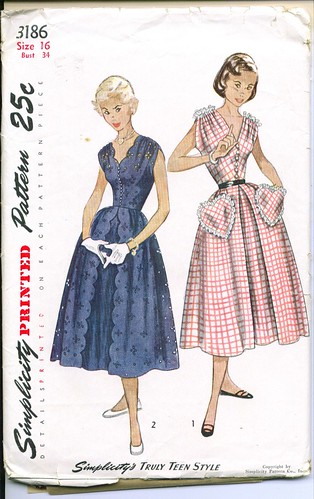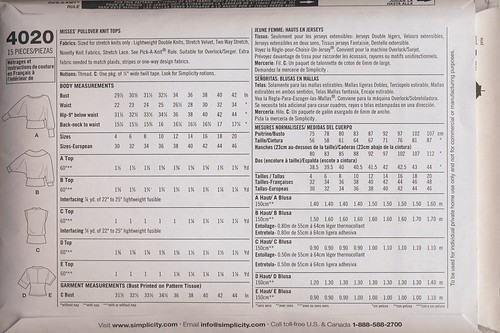image source saraicat
Those who sew know how much easier having a pattern makes sewing, whether it is one you make or one you buy. It seems to me that within the realm of craft and sewing blogs, purchasing a pattern from a Conventional source(i.e. McCalls, Simplicity, etc.) is really looked down on. I think that attitude regarding patterns does a disservice to Beginners.
I think that before sending people out to make their own patterns, beginners should first be taught how to understand and follow directions, and a good place to learn that is from a pattern. After successfully tracing out your clothes, how will you know the order it was pieced together, or by what method to use when sewing on the sleeves? Using patterns when learning is a great way to learn many different techniques and the method and order that is used when sewing clothing.
I think that before sending people out to make their own patterns, beginners should first be taught how to understand and follow directions, and a good place to learn that is from a pattern. After successfully tracing out your clothes, how will you know the order it was pieced together, or by what method to use when sewing on the sleeves? Using patterns when learning is a great way to learn many different techniques and the method and order that is used when sewing clothing.
image source danagraves
Would you send someone with no cooking experience into the kitchen and have them, by taste, reconstruct the Hostess' salsa? The idea sounds absurd! So why the assumption that sewing is different? To teach someone how to cook, you first teach them how to read and follow a recipe, to understand each ingredient, later to change/modify the recipe, and finally to create their own.
image source carbonated
 The Bowser costume I made, started with a pattern for a Turtle that I modified, altered, and changed to meet my needs. There was a lot of pattern making involved for the accessories, the tail, spikes and horns. But using the pattern for the body suit saved me time, because I didn't have to make my own pattern. The finished product barely resembles the pattern example, but it made things smoother for me.
The Bowser costume I made, started with a pattern for a Turtle that I modified, altered, and changed to meet my needs. There was a lot of pattern making involved for the accessories, the tail, spikes and horns. But using the pattern for the body suit saved me time, because I didn't have to make my own pattern. The finished product barely resembles the pattern example, but it made things smoother for me.
Look at the back of this pattern with me, it is very detailed, and includes measurements, materials, correct sizing, and that black bar at the top will help pick the right fabric, with the right amount of stretch. Those are things that one will not learn by deconstructing an article of clothing, and then trying to replicate it.
Using a purchased pattern has some benefits to new sewers that they would not have by making their own. Each pattern includes a directions packet, that includes pattern placement on your fabric, acknowledges seam allowances, and has a glossary of terms that describe what some key words will mean through out the pattern. Each pattern piece has directional marking so that they are cut correctly with the grain of the fabric, not understanding this idea could be responsible for ruing a garment.
After learning how to follow a pattern, and recognizing the steps involved in clothing assembly, I encourage beginners to then try modifying the pattern. Make a change that changes the look of the garment, this will require tracing your pattern, and drawing the changes in so that you can cut your fabric correctly, or maybe you want to change a few steps, after understanding construction and sewing, you will begin to recognize where changes can easily be made.

After you feel comfortable sewing with a pattern, and changing a pattern, then go ahead and construct your own, by tracing existing clothes or starting from scratch. Making your own pattern can be fun and exciting, but best done after the basics are mastered and understood.
Sign up for the mailing lists for your local fabric store before buying patterns, Hancock's and JoAnn's frequently put patterns on sale for $1.99. This would be a great time to find a simple pattern you want to learn with.
Our next lesson will be reading the direction sheet.
Sign up for the mailing lists for your local fabric store before buying patterns, Hancock's and JoAnn's frequently put patterns on sale for $1.99. This would be a great time to find a simple pattern you want to learn with.
Our next lesson will be reading the direction sheet.




2 comments:
Thanks for some more beginner tutorials!
Hey! Totally random comment unrelated to your post here. Sorry. :) I never got an email from you! Blah. I find a bunch of blog related email in my spam box unfortunately. It might have ended up there. I love bloggy friends though! You can try emailing again at theboytrifecta@gmail.com
I have thought about doing that same thing with the Heidi and Finn hoodie. It's just so bulky along that bottom seam. Especially if you are using a knit fabric, leaving the bottom unfinished before you attach the trim would be a great solution!
Post a Comment